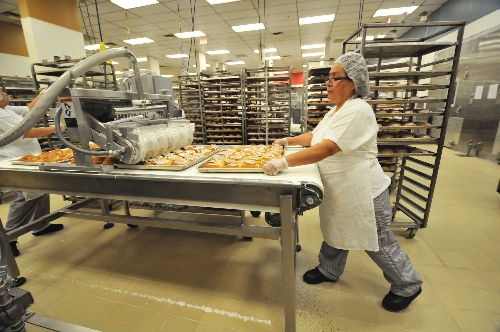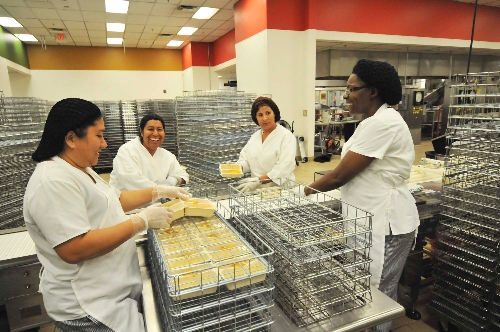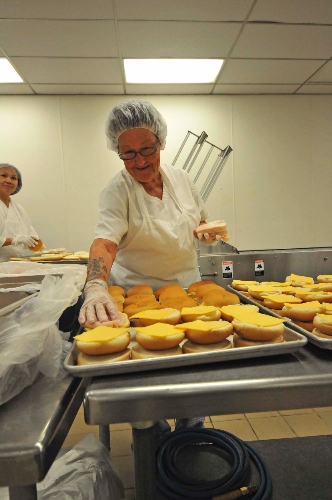Food service coordinator calls school district’s lunch program a ‘balancing act”



Inside a closely guarded, 360,000 square-foot facility near the Las Vegas Motor Speedway, about 150 workers prepare and package meals daily for the Clark County School District’s 350 schools.
It takes an assembly line approach to feed the district’s 175,000 students who eat school lunches. Deliveries are made in cooled trucks throughout the day beginning at 4 a.m. and sometimes running until midnight. Meals are thawed and reheated at the schools.
It’s a big job to feed students in the nation’s fifth-largest school district a healthy meal for $3 or less.
Virginia Beck, coordinator of the district’s Food Service Department, called it a “balancing act.”
“It’s not easy to create menus that the kids want and to keep it within the nutritional standards and the economical restrictions,” she said. “If we prepare food with all the standards and the kids don’t want it, it’s going to go in the garbage.”
Every main entree contains fewer than 600 milligrams of sodium, and fat contributes to less than 30 percent of the total calories. The meals don’t contain any trans fats.
“It’s tough to find foods that meet those standards,” Beck said.
Having such a large school district does entail huge buying power, she said, and manufacturers have been happy to accommodate the healthier food requests.
This year students also have an option to take a piece of fruit with every meal. Beck said the fruit used to be included with the meal, but a lot of it was being thrown away. By giving the kids a choice, it saves the department money, and students seem more apt to eat it because they’re given the option, she said.
Long Elementary School, 2000 S. Walnut Road, is one of 23 elementary schools that participate in the Fresh Fruit and Vegetable Program, a federal grant initiative that provides seasonal fruits and vegetables to kids during class a few days a week.
Principal Joyce Brooks said it’s been a hit among students.
“They love it, and it’s so amazing,” Brooks said. “Most of our students haven’t had these foods before. They try to bring stuff that our kids wouldn’t normally get at home.”
The program delivers mangos, kiwis, radishes, cauliflower and other nontraditional healthy foods to schools with high populations of students on free or reduced lunch programs.
The fresh fruit and vegetables are a good addition, although Brooks said the school lunches overall haven’t been popular among her students, about 80 percent of whom receive free or reduced lunch.
“On a scale of one to five, with five being the greatest, I’d give (school lunches) a two,” Brooks said. “The kids that have to eat them, eat them. Those that can bring their lunch, do.”
Brooks reminisced about the meals she enjoyed as a student growing up in the South, which used to be prepared by individual schools. She said she wishes her students could experience that.
Beck said school lunches are always evolving, and the department is constantly testing new menu items at schools in different regions to see what kids like and making adjustments accordingly.
A big misconception, Beck said, is that menu items such as chicken nuggets or pizza may seem like unhealthy fast-food fare, but they’re better than that.
“Even though it may look or sound the same, it’s entirely different,” Beck said. “It’s really good-quality chicken or good-quality pizzas, and it’s low in fat, it’s low in sodium, and our meals have to provide at least one third of the vitamins and minerals that a child needs daily.”
Kids need those meals more than ever, too.
About 55 percent of the district’s 310,000 students are on the free and reduced lunch program, up from 42 percent in 2007.
Parents can still sign up their children for the free lunch program by visiting applyforlunch.com. For more information about the department, visit ccsd.net/foodservice.
Contact View education reporter Jeff Mosier at jmosier@viewnews.com or 224-5524.












